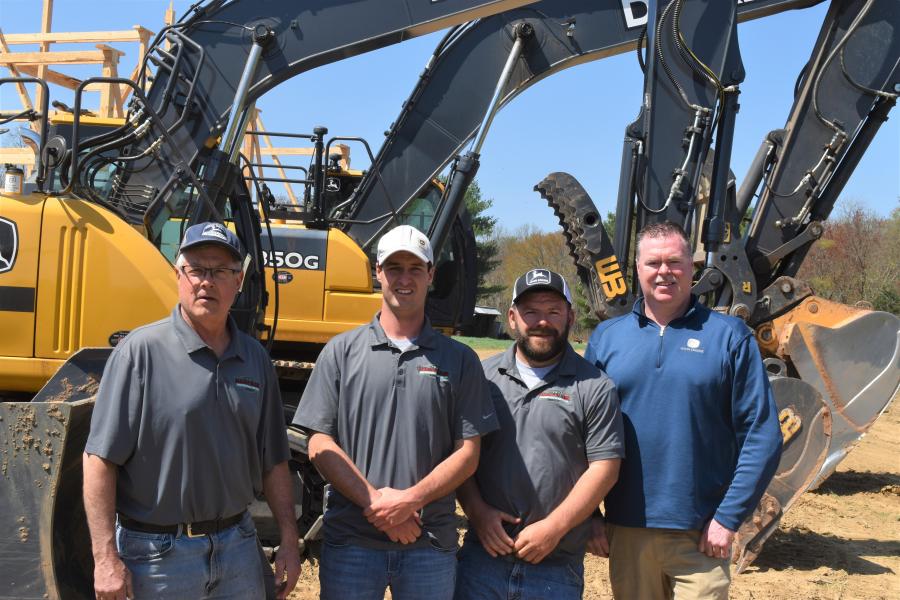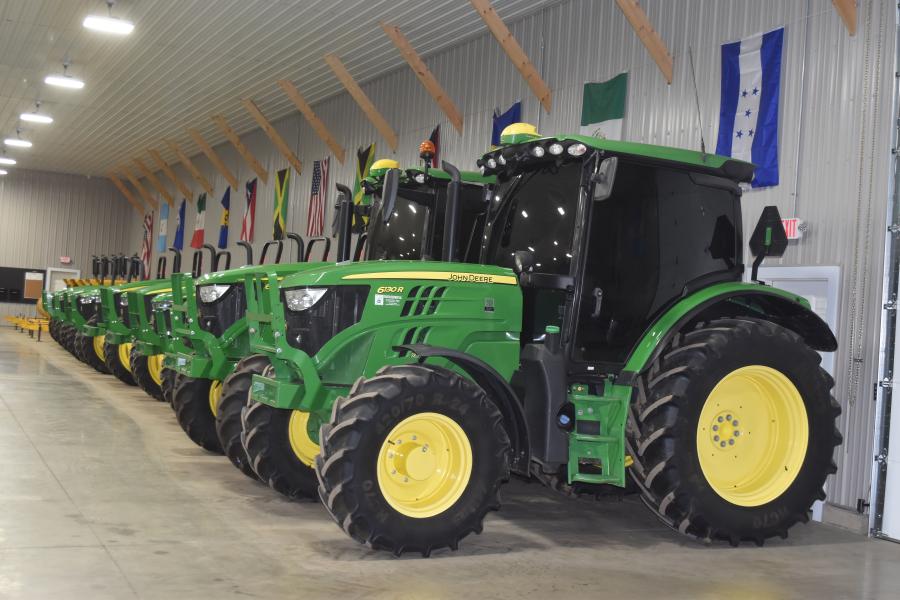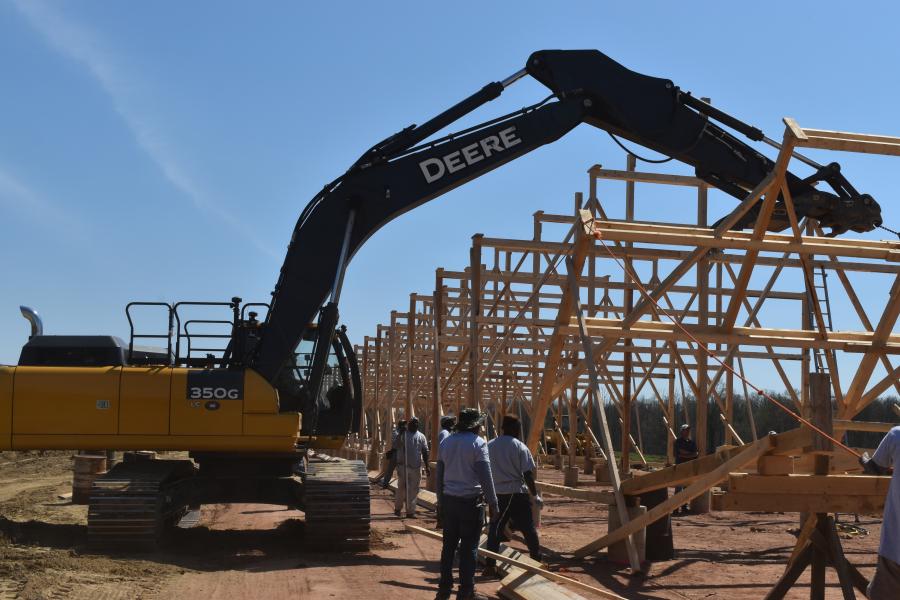(L-R) Steve Jarmoc, Owen Jarmoc and Matt Murkowicz, all of Jarmoc Farms, and Greg Hurlburt, of The W.I. Clark Company.
(CEG photo)
Tobacco growing is a big deal in Connecticut, but unless you live in the Connecticut River Valley, you probably would never know.
If, however, you're driving through the area and see long, rectangular barns that are 200 to 300 ft. long, with wooden vertical siding and no windows, there's a pretty good chance you're looking at what is or was a tobacco farm.
Tobacco growing goes all the way back to the 1600s by the native population. The town of Windsor, Conn., was founded in 1633, and residents soon discovered that the soil conditions and hot, short summers were ideal climate conditions for growing tobacco. At its peak during the Civil War, Connecticut yielded 10 million pounds of tobacco a year, which may have had something to do with an embargo that was in place of southern crops during the war.
As the industry matured, it was found that the conditions were prime in Connecticut for growing high-quality cigar wrapper leaf tobacco, which set the product apart from tobacco grown in the rest of the country. Connecticut growers developed a leaf so smooth and so golden that it ultimately dominated the market for tobacco leaves used as the final wrap in the hand-rolled cigar making process, to the point that Cigar Aficionado magazine referred to Connecticut leaves as "one of the best tasting and looking wrappers available."
Jarmoc Farms in Enfield, Conn., is one of the oldest and largest continuously operating tobacco farms in the state. It also happens to have a growing fleet of John Deere construction equipment that it uses for the farm operation.
Steve Jarmoc and his son, Owen, are the third- and fourth-generation owners of Jarmoc Farms, which was originally started in the early 1900s by Steve's grandfather, Stanley Jarmoc, who emigrated from Poland and initially found work as a farmhand. As a part of his job, he bought supplies at a local farm supply store and one day the owner asked him if he would be interested in owning his own farm. That led to Stanley receiving a $3,400 loan to buy 40 acres of farmland, which is now the family's Home Farm.
Today the Jarmoc's are cultivating approximately 1,000 acres of farmland in and around the Enfield, Conn., area. Over the past several decades, the demand for fine cigars has been very strong and has led to a continual growth curve for the Jarmoc family.
This type of agriculture is particularly labor-intensive. Each seed is planted in a tray and grown to seedling size in a greenhouse. Then, the seedlings by the millions are transplanted to the fields.
When the plants reach about 3-ft. tall, the top flowers are broken off by hand, forcing the plant to broaden to approximately 3-ft. wide and to develop thick leaves, about a dozen per plant. When growing conditions are ideal, the plant will grow by as much as 1 in. per evening.
When the plants have matured, they are chopped down one at a time with a hatchet and are hung upside down in open-sided wooden barns approximately 30-ft. by 300-ft. in size for curing.
The process is incredibly labor-intensive, and to complete the process Jarmoc Farms houses well over 100 migrant workers.
Steve's son, Owen, the new generational leader of Jarmoc Farms, has been bringing the family business into a period of accelerated growth with the acquisition of significant amount of additional property, along with major construction projects to make sure that the infrastructure of the acquired properties can adequately support the tobacco crop. He also has put a heavy emphasis on updating the company's extensive inventory of agricultural equipment.
To accomplish all of the above, Owen, along with Matt Murkowicz, the farm's construction superintendent, have tackled several different categories of construction projects over the past few years.
The Jarmoc family knows the value of keeping their equipment well-maintained and in good working order. Their acreage is spread over a significant geographical area and each tobacco plant must be transported to the tobacco barns. There is equipment needed for the planting process, cultivating, spraying, the list goes on. The end result is a very large inventory of agricultural equipment. They also keep several airplanes for crop monitoring.
To properly house all of the aforementioned equipment, three major equipment buildings with large concrete aprons have been constructed.
Maintaining the ideal moisture content of the soil for proper tobacco growth is critical. As Steve and Owen have acquired more property, significant drainage projects have been tackled along with the construction of required drainage ponds.
For every 8 acres of expanded production at least one new tobacco barn needs to be built. Each of these barns are constructed from the same materials, in the same design, that they were built 100 years ago. With the farm growing by hundreds of acres, quite a number of barns have been built or are currently under plans to be built.
"With the number of projects that we were looking at, it just made sense to start investing in our own heavy equipment and tackling as many of these projects on our own as possible." Owen said. "The workers that we use for our fieldwork are extremely willing and hard-working people and Matt Murkowicz's background is in operating heavy construction equipment.
"When we started updating our agricultural tractor fleet we went with John Deere whenever possible. John Deere has been a great experience for us, so it made sense to move in that direction with the construction equipment. Of course, we were dealing with a different dealership, The W.I. Clark Company, but we immediately hit it off well with their representative Greg Hurlburt, who has taken very good care of us.
"We needed a wide range of equipment in a variety of different sizes. We are using excavators with the barn construction to lift the trusses in place, so we needed reasonable amounts of reach. Some of the ponds that we are building are significant in size, so we determined that we needed a good size dozer, and we needed some compact machines for other projects. It's been great working with Greg and getting his guidance in purchasing this equipment.
"At times, the service from Greg was over the top. He's our sales rep, not our service rep, yet there have been times when I have needed product support and he has shown up within an hour with the part I needed. We went with him to ConExpo to look at the John Deere 850L. It's a major investment, but we are very excited about getting the machine, and equally as excited about getting a machine that is already integrated with Smart Grade Control."
Currently, Jarmoc Farms has in inventory a John Deere 333G tracked skid steer; a 544P wheel loader; a 350G excavator; a 135P excavator; a 544H loader; a 700L dozer; a 850 dozer; and an 850L dozer on order.
For more information, visit www.wiclark.com. CEG
Today's top stories




































